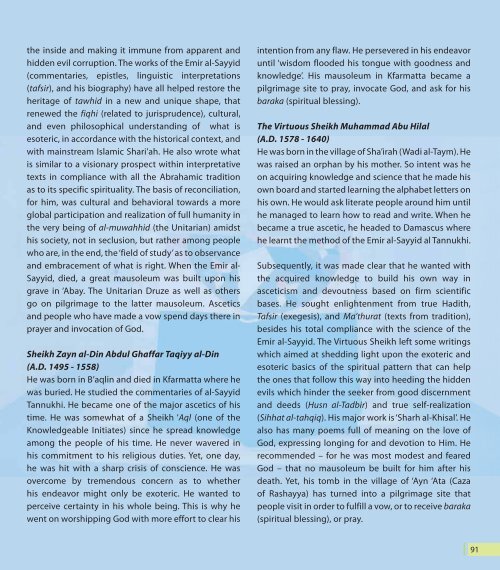Cultural aspects in Christian and Islamic religions - unesdoc - Unesco
Cultural aspects in Christian and Islamic religions - unesdoc - Unesco
Cultural aspects in Christian and Islamic religions - unesdoc - Unesco
Create successful ePaper yourself
Turn your PDF publications into a flip-book with our unique Google optimized e-Paper software.
the <strong>in</strong>side <strong>and</strong> mak<strong>in</strong>g it immune from apparent <strong>and</strong><br />
hidden evil corruption. The works of the Emir al-Sayyid<br />
(commentaries, epistles, l<strong>in</strong>guistic <strong>in</strong>terpretations<br />
(tafsir), <strong>and</strong> his biography) have all helped restore the<br />
heritage of tawhid <strong>in</strong> a new <strong>and</strong> unique shape, that<br />
renewed the fiqhi (related to jurisprudence), cultural,<br />
<strong>and</strong> even philosophical underst<strong>and</strong><strong>in</strong>g of what is<br />
esoteric, <strong>in</strong> accordance with the historical context, <strong>and</strong><br />
with ma<strong>in</strong>stream <strong>Islamic</strong> Shari’ah. He also wrote what<br />
is similar to a visionary prospect with<strong>in</strong> <strong>in</strong>terpretative<br />
texts <strong>in</strong> compliance with all the Abrahamic tradition<br />
as to its specific spirituality. The basis of reconciliation,<br />
for him, was cultural <strong>and</strong> behavioral towards a more<br />
global participation <strong>and</strong> realization of full humanity <strong>in</strong><br />
the very be<strong>in</strong>g of al-muwahhid (the Unitarian) amidst<br />
his society, not <strong>in</strong> seclusion, but rather among people<br />
who are, <strong>in</strong> the end, the ‘field of study’ as to observance<br />
<strong>and</strong> embracement of what is right. When the Emir al-<br />
Sayyid, died, a great mausoleum was built upon his<br />
grave <strong>in</strong> ‘Abay. The Unitarian Druze as well as others<br />
go on pilgrimage to the latter mausoleum. Ascetics<br />
<strong>and</strong> people who have made a vow spend days there <strong>in</strong><br />
prayer <strong>and</strong> <strong>in</strong>vocation of God.<br />
Sheikh Zayn al-D<strong>in</strong> Abdul Ghaffar Taqiyy al-D<strong>in</strong><br />
(A.D. 1495 - 1558)<br />
He was born <strong>in</strong> B’aql<strong>in</strong> <strong>and</strong> died <strong>in</strong> Kfarmatta where he<br />
was buried. He studied the commentaries of al-Sayyid<br />
Tannukhi. He became one of the major ascetics of his<br />
time. He was somewhat of a Sheikh ‘Aql (one of the<br />
Knowledgeable Initiates) s<strong>in</strong>ce he spread knowledge<br />
among the people of his time. He never wavered <strong>in</strong><br />
his commitment to his religious duties. Yet, one day,<br />
he was hit with a sharp crisis of conscience. He was<br />
overcome by tremendous concern as to whether<br />
his endeavor might only be exoteric. He wanted to<br />
perceive certa<strong>in</strong>ty <strong>in</strong> his whole be<strong>in</strong>g. This is why he<br />
went on worshipp<strong>in</strong>g God with more effort to clear his<br />
<strong>in</strong>tention from any flaw. He persevered <strong>in</strong> his endeavor<br />
until ‘wisdom flooded his tongue with goodness <strong>and</strong><br />
knowledge’. His mausoleum <strong>in</strong> Kfarmatta became a<br />
pilgrimage site to pray, <strong>in</strong>vocate God, <strong>and</strong> ask for his<br />
baraka (spiritual bless<strong>in</strong>g).<br />
The Virtuous Sheikh Muhammad Abu Hilal<br />
(A.D. 1578 - 1640)<br />
He was born <strong>in</strong> the village of Sha’irah (Wadi al-Taym). He<br />
was raised an orphan by his mother. So <strong>in</strong>tent was he<br />
on acquir<strong>in</strong>g knowledge <strong>and</strong> science that he made his<br />
own board <strong>and</strong> started learn<strong>in</strong>g the alphabet letters on<br />
his own. He would ask literate people around him until<br />
he managed to learn how to read <strong>and</strong> write. When he<br />
became a true ascetic, he headed to Damascus where<br />
he learnt the method of the Emir al-Sayyid al Tannukhi.<br />
Subsequently, it was made clear that he wanted with<br />
the acquired knowledge to build his own way <strong>in</strong><br />
asceticism <strong>and</strong> devoutness based on firm scientific<br />
bases. He sought enlightenment from true Hadith,<br />
Tafsir (exegesis), <strong>and</strong> Ma’thurat (texts from tradition),<br />
besides his total compliance with the science of the<br />
Emir al-Sayyid. The Virtuous Sheikh left some writ<strong>in</strong>gs<br />
which aimed at shedd<strong>in</strong>g light upon the exoteric <strong>and</strong><br />
esoteric basics of the spiritual pattern that can help<br />
the ones that follow this way <strong>in</strong>to heed<strong>in</strong>g the hidden<br />
evils which h<strong>in</strong>der the seeker from good discernment<br />
<strong>and</strong> deeds (Husn al-Tadbir) <strong>and</strong> true self-realization<br />
(Sihhat al-tahqiq). His major work is ‘Sharh al-Khisal’. He<br />
also has many poems full of mean<strong>in</strong>g on the love of<br />
God, express<strong>in</strong>g long<strong>in</strong>g for <strong>and</strong> devotion to Him. He<br />
recommended – for he was most modest <strong>and</strong> feared<br />
God – that no mausoleum be built for him after his<br />
death. Yet, his tomb <strong>in</strong> the village of ‘Ayn ‘Ata (Caza<br />
of Rashayya) has turned <strong>in</strong>to a pilgrimage site that<br />
people visit <strong>in</strong> order to fulfill a vow, or to receive baraka<br />
(spiritual bless<strong>in</strong>g), or pray.<br />
91

















